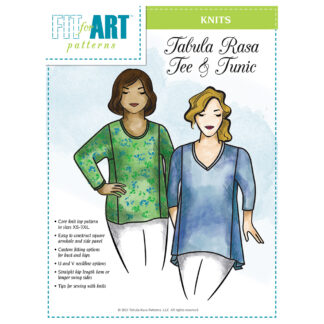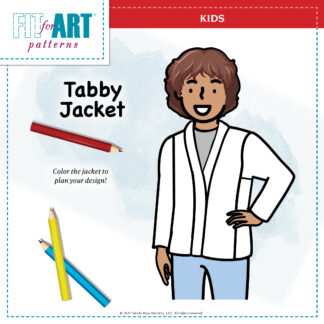
I first conceived and started this Tabula Rasa Boro Vest project three years ago. Along the way it was put aside and picked up occasionally to work on during an extended car trip or the like. Last month I vowed to get it done in time for the upcoming Original Sewing & Quilt Expo in Fredericksburg. As you can see…. I finally finished it!
These photos show the pieced back and fronts and the single fabric side panel before boro stitching was begun. As you’ll see in progress photos, I chose different thread colors and running stitch patterns for each patch! To learn more about the beginnings of this project and the materials I used, visit the blog post Boro Report.
Joining the Shoulder Seams
After completing the hand stitching on all 5 vest pieces, I was finally ready to put it together. The process for assembling the pieces is similar to assembling a reversible Tabula Rasa Jacket. These photos of joining the front and back shoulder seams illustrate the process :
- Machine sew the backing and middle layers right sides together on the seam line without catching the outer layers.
- Press open the seam allowances and trim each side to about 1/4”.
- Cover the seam with the outer layers. For this seam, I chose to lay the back shoulder down first and layer the front shoulder over it.
- Boro stitch through all layers to anchor the outer fabric.
There are loose threads because I quickly discovered that I had boro stitched too close to the seam linesand had to pull out several lines of stitching on each shoulder to accommodate the seam allowances. I can now tell you with great certainty that you should stop your boro stitching more than one inch from each edge, leaving room to manipulate the seams allowances! Here are the finished shoulder seams.
Inserting the Side Panels
The next step was to insert the side panels into the fronts and backs. The Tabula Rasa square armhole construction makes this as easy as it could possibly be with 4 straight seams! If you’ve never made a vest with your Tabula Rasa Jacket pattern, check out these free download instructions to see how it works. Before inserting the side panels, I bound the top raw edges with a blue cotton fabric that was textured enough to live happily with the ikat patches for the band. This fabric also makes an appearance as the kimono band and for finishing the armholes and hem.
Like the shoulder seams, the backing and middle layers were stitched right sides together along each side seam, the seam allowances pressed open and trimmed. But this is where I had to do a little jerry-rigging as I had again taken my boro stitches too close on the fronts and backs to accommodate the seam allowances. I had realized my mistake by the time I got to boro stitching the side panels, so I stopped stitching about 1¼” from each edge. Instead of leaving the seam allowances pressed open, I pressed them both towards the side panels.
To cover the seams, I decided to lay the side panel fabric down first, trimming it to fit within the narrow space left in the fronts and backs. Secondly, I layered the front and back patches over the side panel. Finally, I secured all the layers over the seams with boro stitching to match each patch. Phew!
Finishing the Armholes
After adding both side panels, all that was left was to finish the armholes and hem and add the band. The instructions for Making a Tabula Rasa Vest explains two ways of finishing the armholes – an “extended shoulder” with binding wrapped around the raw edge, or a “natural shoulder” with binding turned entirely to the inside. I opted for the natural shoulder method, illustrated here.
And voila a beautifully finished armhole! I finished the hem by the same method as the armhole, attaching a binding (or you could consider it a facing) and turning it entirely to the inside of the garment. In both places, I hand stitched the bindings to the inside to retain a supple edge; I often find that using a machine stitch-in-the ditch technique creates a more rigid edge that won’t relax over the roundness of my shoulder. I also know that I will not be machine washing this vest, which would be harder on hand stitched finishes.
Gotta have a Pocket!
At the last minute, I decided I wanted pockets in the vest. It would have been smarter to add this before finishing the hem in order to secure the pocket’s bottom edge into the seam. I was at least able to anchor one edge of the pocket in the center front seam with the band, then hand stitched the remainder. I was also able to camouflage a line of machine stitching between two patches to divide the pocket into 2 narrower sections to securely hold a credit card, money, ID or hotel key.
The final step – the Kimono Front Band
Finally, I chose a basic Tabula Rasa kimono-style band to finish my vest. After considering a narrow 1” wide band, I settled on 1½” wide to accommodate and set off the fabulous vintage buttons I found for it back at the beginning of this project.
This was a long and sometimes laborious project, but I share it with you to encourage you not to give up on your UFOs. I love the vest and will be wearing it a lot this fall and winter! With any luck, I’ll also get a red Tabula Rasa Knit Tee sewed up to wear with it. Come by Fit for Art’s booth at the Fredericksburg Expo to see it in person this weekend.
Happy Sewing, Carrie
































I love Boro ! And this vest is a beautiful creation. I will be sure to refer to the blog as inspiration for my own Boro project.
Thank you for shareing, Maryann
Thank you Maryann! We’d love to see your Boro creation, too!
Fun Boro vest Carrie! The fabrics looks like they lent themselves well to stitch embellishment. I enjoyed looking at all of the fabrics and the colorful stitching. Thanks for offering all of the pictures, so we could get a good look. I hope you enjoy wearing it this Fall.
My kind of clothes. But what does boro mean?
Boro refers to the technique of using scraps an running stitches to patch garments, here turned into more of an art form. Search for “borough” in our blog archive for more info.